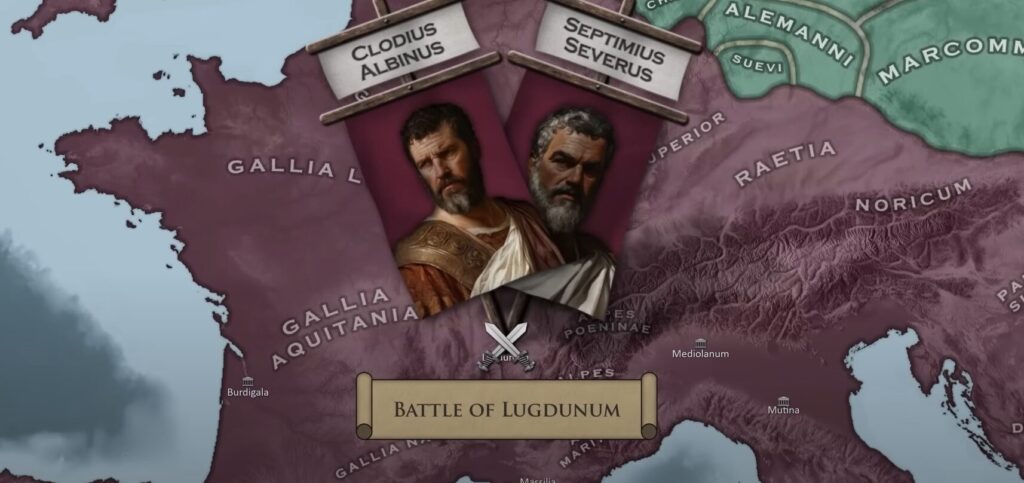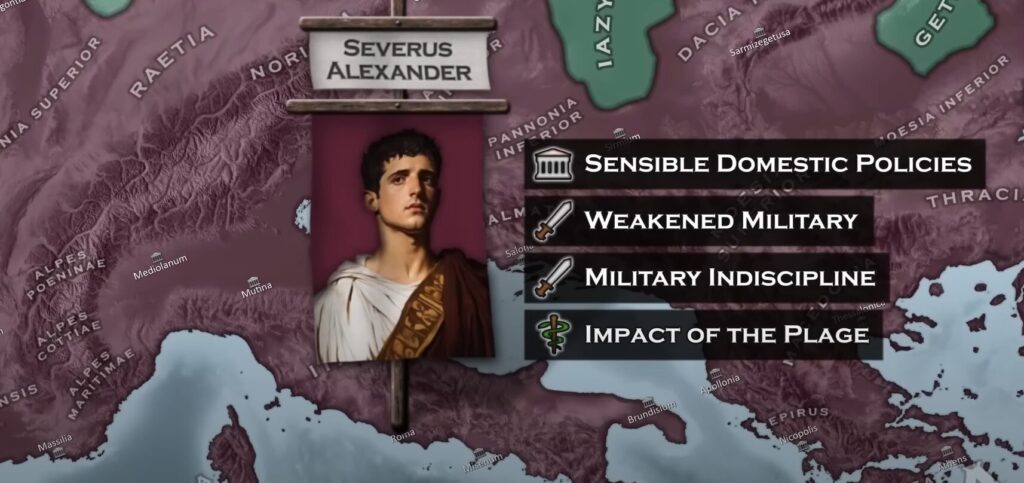After the death of Marcus Aurelius in 180 AD, Rome entered a time of major change. The long rule of stable and wise emperors ended. Instead, unrest, economic problems, and power struggles became common. Commodus, who followed his father Marcus Aurelius, steered the empire in a very different direction, focusing on public spectacle and personal gain rather than strong leadership.
The years after Commodus saw quick changes in rulers and growing chaos. Septimius Severus brought some reforms and tried to restore order, but challenges remained. The Severan dynasty saw both achievements and more troubles, which weakened Rome’s strength and led to further instability.
Key Takeaways
- The period after Marcus Aurelius saw the end of long-lasting stability.
- Short reigns and frequent power struggles became common.
- Reforms could not fully stop the empire’s decline.
The Fall of the Five Righteous Leaders
Lasting Effects of Marcus Aurelius
Marcus Aurelius was known for his thoughtful ways and deep thinking. He believed in self-control and clear judgment, which shaped the way he ruled.
Though his time as emperor was full of battles on the empire’s borders, things inside Rome stayed calm and steady. His focus on order and stability left a strong mark on Roman society and culture.
His passing marked the end of the wise leadership that had guided Rome through peaceful and wealthy years.
| Emperor | Main Qualities | Internal Condition | External Challenges |
|---|---|---|---|
| Marcus Aurelius | Thoughtful, Philosophic | Stable and Prosperous | Wars on Borders |
| Commodus | Indulgent, Reckless | Growing Instability | Less Focus on Security |
Change After the Peaceful Era
The years before 180 AD are often called Rome’s golden years. During that time, Rome saw big growth in wealth, the arts, and building projects.
After Marcus Aurelius’s death, things changed fast. Commodus, his son, ruled with less care. He put more attention on games and personal joy than the empire’s needs.
After Commodus, emperors took turns leading for short periods. Battles for power and sudden deaths became regular. This new era brought economic troubles and more threats from outside, which slowly weakened Rome’s strength.
Commodus: Ascension and Authority
Differences with Marcus Aurelius
Commodus replaced his father, Marcus Aurelius, as emperor in 180 AD. Marcus Aurelius had been a thoughtful, philosophical ruler whose leadership reflected stoic values and a steady temperament. In contrast, Commodus did not display the same calm or strategic mindset. His decisions and personal style differed sharply, veering towards self-indulgence and pleasure rather than careful governance.
- Marcus Aurelius: Stoic, stable, focused on long-term strength
- Commodus: Indulgent, impulsive, centered on entertainment and personal power
Financial Troubles and Citizen Unrest
Under Commodus, the economy began to weaken. Bad decisions, especially in farming, caused major problems with food supply. This led many people to store up grain, making shortages and problems worse. These conditions made the public feel uneasy and helped spread fear, especially as the threat of disease loomed.
| Cause | Effect |
|---|---|
| Poor farming policies | Grain hoarding, shortages |
| Economic instability | Lowered public mood, fear spreading |
Entertaining Rome: Games and Gladiators
Commodus put a huge emphasis on putting on shows for the people. Gladiator games became far more common and extravagant. He even entered the arena himself, fighting as a gladiator in events that were clearly staged for his victory. Wild animals were shipped in from Africa in record numbers for these battles. His actions in the arena, shooting weapons and killing animals, were new for an emperor and shocked many people.
Key Features:
- Increased frequency of gladiator games
- Commodus himself fighting and performing in public
- Large-scale animal fights and historical reenactments
- Public opinion divided between fascination and concern for the emperor’s image
Power Struggles and Commodus’ Violent End

Commodus lacked the political skill and restraint of earlier emperors. He made enemies in his own court and among close friends. In 193 AD, a conspiracy led to his murder by someone he trusted, marking a violent and unstable end to his rule. This event signaled the start of a pattern, as emperors after Commodus also faced short reigns and were often killed by those near them.
- Internal betrayal became common
- Emperors struggled to hold on to power
- Rapid change and violence followed Commodus’ death
The Year When Five Ruled Rome
Quick Changes in Power and Unrest
After Commodus’s death, Rome faced a year of fast changes and chaos. In 193 AD, five different men tried to claim the throne. Each new ruler came to power quickly, but few stayed long. Assassinations and betrayals became common.
Here’s a simple look at the rapid turnover:
| Emperor | How They Gained Power | How Their Rule Ended |
|---|---|---|
| Pertinax | Chosen by Senate | Killed by Praetorian Guard |
| Didius Julianus | Bought the throne | Executed |
| Pescennius Niger | Declared emperor by troops | Defeated in battle |
| Clodius Albinus | Supported by legions | Defeated in battle |
| Septimius Severus | Marched on Rome | Secured control |
This period brought economic trouble and fear. Many citizens did not know who would rule next. Army loyalty decided much of the fighting. Violence and bribes became part of politics.
Septimius Severus Rises to Power
Septimius Severus, a skilled general with roots in North Africa, eventually took control. He brought changes to both the army and government.
Key steps Severus took as emperor:
- Improved pay and conditions for soldiers to ensure their support
- Removed officials accused of corruption
- Supported building projects, especially in African cities
- Tried to stop the wasteful habits started under Commodus
Severus was respected for his strong leadership, especially by everyday people. The Senate, however, disliked his military path to power and his harsh treatment of those he saw as corrupt.
Septimius Severus’s reign marked a turning point. Rome saw some stability again, but the way he ruled—with strong military support—became a new model for future emperors.
Policies and Campaigns of Septimius Severus
Changes in Military and Administration
Septimius Severus brought several changes to the Roman military and government. He raised the pay for soldiers, which helped to keep their loyalty during unstable times. He also started charging senators with corruption, leading to many executions.
Military Reforms Table
| Reform Area | Description |
|---|---|
| Soldier Pay | Increased wages for soldiers |
| Discipline | Focused on loyalty and efficiency |
| Senate Actions | Executed corrupt officials |
These efforts made him more popular with regular citizens, but not with members of the senate.
Improving Cities in Africa
Severus supported African cities by giving them more money and attention. He funded public works and boosted their importance in the empire. Some projects included building and repairing important structures. These actions strengthened his connection to his birthplace and helped these regions grow.
List of Actions:
- Extra funding for city projects
- Repairs of public buildings
- Raising the profile of African cities in the Roman world
Advances Northward in Britain

Severus is known for his large campaigns in Britain. In 209 and 210 AD, he led up to 50,000 soldiers and a big naval fleet north beyond Hadrian’s Wall.
He rebuilt forts and kept troops stationed in areas Rome had not controlled for years. His goal was to defeat the local tribes in what is now Scotland. The army faced hard fights, with surprise attacks from the tribes, especially in narrow valleys and marshes.
As the campaign continued, Romans had to deal with supply problems and tough weather. Some troops even took desperate measures to avoid being captured by the enemy. After some early victories, his soldiers had to deal with new rebellions from tribes they had just subdued. Severus handed control to his son Caracalla before dying in York, never returning to Rome.
The Severan Family and Its Problems
Tensions with the Senate and Use of Force
Septimius Severus took power mostly through the support of the army, not by working with the Senate. He distrusted senators and saw them as rivals. Many senators were put to death after being accused of corruption. Severus raised soldier pay, which made the soldiers more loyal to him than to the Senate, further weakening its power.
Here is a comparison of support:
| Group | Septimius Severus’ Support |
|---|---|
| Army | Very Strong |
| Senate | Very Weak |
| People | Mostly Supportive |
Caracalla’s Rule and the Death of Geta
When Severus died, he named his sons Caracalla and Geta to share the throne. This did not last. Caracalla wanted all the power and had Geta killed during a fake peace meeting at their mother’s home. After this, Caracalla ruled alone. This murder was a dark moment in the family’s history.
- Caracalla: Oldest son, became sole emperor
- Geta: Younger son, killed in a plot
Short-Lived Rules of Macrinus and Elagabalus
Caracalla was replaced by a new ruler, Macrinus, but he only lasted a bit over a year. Next came Elagabalus, a cousin of Caracalla. Elagabalus’ leadership was full of rumors and stories of odd behavior. He did not follow Roman traditions and became unpopular with many Romans. Elagabalus ruled for about four years before being removed.
List of Short Rulers:
- Macrinus (just over one year)
- Elagabalus (about four years)
The Leadership of Alexander Severus
After Elagabalus, Alexander Severus became emperor. He managed to rule longer than those before him. Alexander tried to govern fairly and brought some good changes. However, the army started to lose its discipline during his time. The Praetorian Guard, a key force in Rome, became less reliable, and this caused more problems for the empire.
Key points about Alexander Severus:
- Ruled longer than other Severans
- Brought some stability and reforms
- Struggled with disloyal soldiers
Declining Security and Build-Up to Crisis
Brief Reigns and Rising Internal Danger
After Marcus Aurelius died, emperors did not rule for long periods. Power changed hands with violence and betrayal, making Rome unstable. Assassinations and plots became common. For example, Commodus was killed by his own close associates, and Caracalla arranged his own brother’s murder to gain sole control.
Key Factors:
- Fast turnover of emperors
- Increased assassinations
- Civil unrest in Rome
These events led to a feeling of danger within the empire, with loyalties often shifting and government lacking steady guidance.
Reduced Strength of the Armed Forces
Rome’s military also began to lose its edge. While a few leaders, such as Septimius Severus, tried to keep the army strong with better pay and reforms, discipline started to break down. The elite guards in Rome were no longer as loyal or organized as before.
| Period | Characteristics |
|---|---|
| Under Severus | Military reforms, higher pay |
| Later years | Loss of discipline, weak guards |
This loss in military strength meant Rome was less able to deal with threats.
Decline of Emperor’s Power
The emperors’ power became less secure. Public shows and excesses, like those seen under Commodus, led many to question the respect for the office. The Senate grew more hostile, especially when military men took power or punished officials.
- Weak rule and scandal lowered trust.
- The Senate and emperor often clashed.
- Power was sometimes won by force, not respect.
These changes reduced the emperor’s control over Rome and made it easier for rivals to challenge them.
